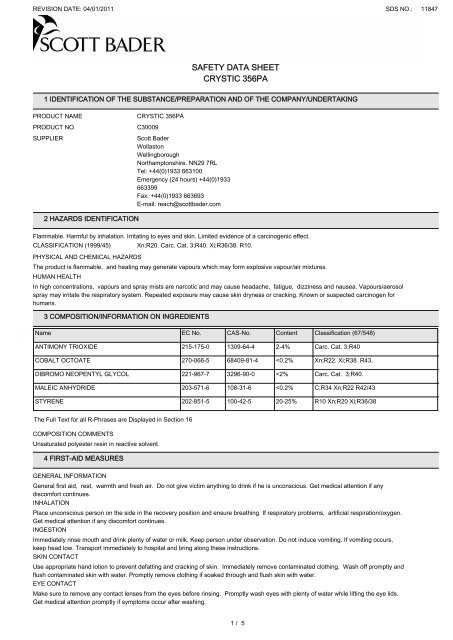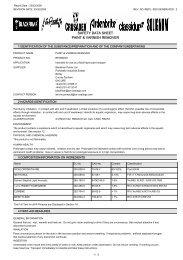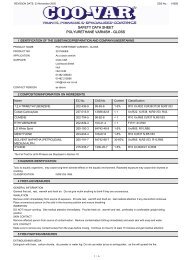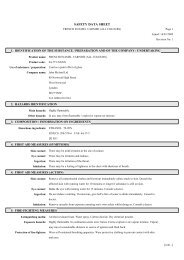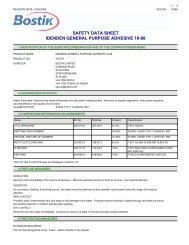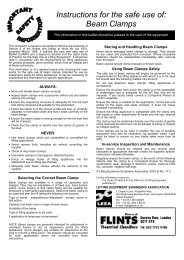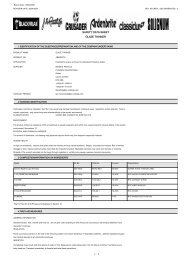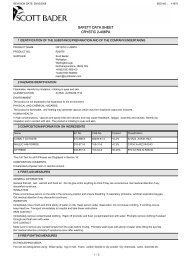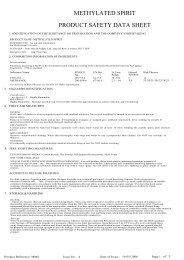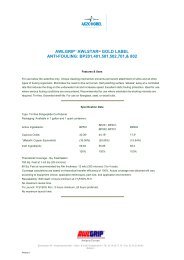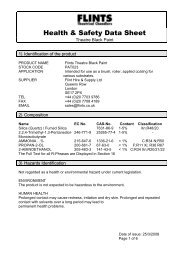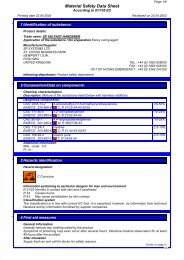SAFETY DATA SHEET CRYSTIC 356PA - Flint Hire & Supply
SAFETY DATA SHEET CRYSTIC 356PA - Flint Hire & Supply
SAFETY DATA SHEET CRYSTIC 356PA - Flint Hire & Supply
Create successful ePaper yourself
Turn your PDF publications into a flip-book with our unique Google optimized e-Paper software.
REVISION DATE: 04/01/2011 SDS NO.: 11847<br />
<strong>SAFETY</strong> <strong>DATA</strong> <strong>SHEET</strong><br />
<strong>CRYSTIC</strong> <strong>356PA</strong><br />
1 IDENTIFICATION OF THE SUBSTANCE/PREPARATION AND OF THE COMPANY/UNDERTAKING<br />
PRODUCT NAME<br />
PRODUCT NO.<br />
SUPPLIER<br />
<strong>CRYSTIC</strong> <strong>356PA</strong><br />
C30009<br />
Scott Bader<br />
Wollaston<br />
Wellingborough<br />
Northamptonshire. NN29 7RL<br />
Tel: +44(0)1933 663100<br />
Emergency (24 hours) +44(0)1933<br />
663399<br />
Fax: +44(0)1933 663693<br />
E-mail: reach@scottbader.com<br />
2 HAZARDS IDENTIFICATION<br />
Flammable. Harmful by inhalation. Irritating to eyes and skin. Limited evidence of a carcinogenic effect.<br />
CLASSIFICATION (1999/45) Xn;R20. Carc. Cat. 3;R40. Xi;R36/38. R10.<br />
PHYSICAL AND CHEMICAL HAZARDS<br />
The product is flammable, and heating may generate vapours which may form explosive vapour/air mixtures.<br />
HUMAN HEALTH<br />
In high concentrations, vapours and spray mists are narcotic and may cause headache, fatigue, dizziness and nausea. Vapours/aerosol<br />
spray may irritate the respiratory system. Repeated exposure may cause skin dryness or cracking. Known or suspected carcinogen for<br />
humans.<br />
3 COMPOSITION/INFORMATION ON INGREDIENTS<br />
Name EC No. CAS-No. Content Classification (67/548)<br />
ANTIMONY TRIOXIDE 215-175-0 1309-64-4 2-4% Carc. Cat. 3;R40<br />
COBALT OCTOATE 270-066-5 68409-81-4
REVISION DATE: 04/01/2011 SDS NO.: 11847<br />
5 FIRE-FIGHTING MEASURES<br />
<strong>CRYSTIC</strong> <strong>356PA</strong><br />
EXTINGUISHING MEDIA<br />
Fire can be extinguished using: Water spray, fog or mist. Foam, carbon dioxide or dry powder. Dry chemicals, sand, dolomite etc. Do<br />
not use water jet as an extinguisher, as this will spread the fire.<br />
SPECIAL FIRE FIGHTING PROCEDURES<br />
Use pressurised air mask if product is involved in a fire. Cool containers exposed to flames with water until well after the fire is out. Keep<br />
run-off water out of sewers and water sources. Dike for water control.<br />
UNUSUAL FIRE & EXPLOSION HAZARDS<br />
Fire causes formation of toxic gases.<br />
PROTECTIVE MEASURES IN FIRE<br />
Self contained breathing apparatus and full protective clothing must be worn in case of fire.<br />
6 ACCIDENTAL RELEASE MEASURES<br />
PERSONAL PRECAUTIONS<br />
Wear protective clothing as described in Section 8 of this safety data sheet.<br />
ENVIRONMENTAL PRECAUTIONS<br />
Spillages or uncontrolled discharges into watercourses must be IMMEDIATELY alerted to the Environmental Agency or other appropriate<br />
regulatory body.<br />
SPILL CLEAN UP METHODS<br />
Keep combustibles away from spilled material. Extinguish all ignition sources. Avoid sparks, flames, heat and smoking. Ventilate.<br />
Absorb in vermiculite, dry sand or earth and place into containers. Wash thoroughly after dealing with a spillage.<br />
7 HANDLING AND STORAGE<br />
USAGE PRECAUTIONS<br />
Keep away from heat, sparks and open flame. Avoid spilling, skin and eye contact. Ventilate well, avoid breathing vapours. Use<br />
approved respirator if air contamination is above accepted level. Vapours are heavier than air and may spread near ground to sources of<br />
ignition.<br />
STORAGE PRECAUTIONS<br />
Flammable/combustible - Keep away from oxidisers, heat and flames. Store in tightly closed original container in a dry, cool and<br />
well-ventilated place. Keep in original container. Avoid contact with oxidising agents.<br />
STORAGE CLASS<br />
Flammable liquid storage.<br />
8 EXPOSURE CONTROLS/PERSONAL PROTECTION<br />
Name<br />
STYRENE<br />
Std<br />
TWA - 8 hrs<br />
STEL - 15 min<br />
WEL 100 ppm 430 mg/m3 250 ppm 1080 mg/m3<br />
Notes<br />
WEL = Workplace Exposure Limit.<br />
INGREDIENT COMMENTS<br />
WEL = Workplace Exposure Limits Due to the hazardous nature of ingredients, exposure should be minimal.<br />
PROTECTIVE EQUIPMENT<br />
PROCESS CONDITIONS<br />
Provide eyewash station.<br />
ENGINEERING MEASURES<br />
Provide adequate ventilation, including appropriate local extraction, to ensure that the defined occupational exposure limit is not<br />
exceeded. All handling to take place in well-ventilated area.<br />
RESPIRATORY EQUIPMENT<br />
Provide adequate ventilation. Observe Occupational Exposure Limits and minimise the risk of inhalation of vapours. At work in confined or<br />
poorly ventilated spaces, respiratory protection with air supply must be used. Wear mask supplied with: Gas cartridge suitable for organic<br />
substances.<br />
HAND PROTECTION<br />
For prolonged or repeated skin contact use suitable protective gloves. Use protective gloves made of: Neoprene. Nitrile. Rubber (natural,<br />
latex).<br />
2 / 5
REVISION DATE: 04/01/2011 SDS NO.: 11847<br />
EYE PROTECTION<br />
Wear splash-proof eye goggles to prevent any possibility of eye contact.<br />
OTHER PROTECTION<br />
Wear appropriate clothing to prevent any possibility of skin contact.<br />
HYGIENE MEASURES<br />
<strong>CRYSTIC</strong> <strong>356PA</strong><br />
DO NOT SMOKE IN WORK AREA! Wash at the end of each work shift and before eating, smoking and using the toilet. Promptly remove<br />
any clothing that becomes contaminated. Use appropriate skin cream to prevent drying of skin. When using do not eat, drink or smoke.<br />
9 PHYSICAL AND CHEMICAL PROPERTIES<br />
APPEARANCE<br />
COLOUR<br />
ODOUR<br />
SOLUBILITY<br />
Viscous liquid<br />
Varying<br />
Solvent.<br />
BOILING POINT (°C) 50-150<br />
Insoluble in water<br />
RELATIVE DENSITY 1.10 - 1.20 25°C<br />
FLASH POINT (°C)<br />
10 STABILITY AND REACTIVITY<br />
32 CC (Closed cup).<br />
STABILITY<br />
Stable under normal temperature conditions.<br />
CONDITIONS TO AVOID<br />
Avoid exposure to high temperatures or direct sunlight.<br />
HAZARDOUS POLYMERISATION<br />
May polymerise.<br />
MATERIALS TO AVOID<br />
Alkali metals. Strong oxidising substances. Strong acids. Strong alkalis. Organic peroxides/hydroperoxides. Inorganic peroxides.<br />
HAZARDOUS DECOMPOSITION PRODUCTS<br />
Thermal decomposition or combustion may liberate carbon oxides and other toxic gases or vapours.<br />
11 TOXICOLOGICAL INFORMATION<br />
GENERAL INFORMATION<br />
Prolonged and repeated contact with solvents over a long period may lead to permanent health problems. Organic solvents may be<br />
absorbed into the body by inhalation and ingestion and cause permanent damage to the nervous system, including the brain.<br />
INHALATION<br />
In high concentrations, vapours may irritate throat and respiratory system and cause coughing. In high concentrations, vapours are<br />
narcotic and may cause headache, fatigue, dizziness and nausea. Gas or vapour is harmful on prolonged exposure or in high<br />
concentrations.<br />
INGESTION<br />
Gastrointestinal symptoms, including upset stomach.<br />
SKIN CONTACT<br />
Acts as a defatting agent on skin. May cause cracking of skin, and eczema. Irritating to skin. May be absorbed through the skin.<br />
EYE CONTACT<br />
Irritation of eyes and mucous membranes.<br />
OTHER HEALTH EFFECTS<br />
Carcinogen Category 3.<br />
12 ECOLOGICAL INFORMATION<br />
ECOTOXICITY<br />
Dangerous for the environment: May cause long-term adverse effects in the aquatic environment.<br />
13 DISPOSAL CONSIDERATIONS<br />
GENERAL INFORMATION<br />
Waste to be treated as controlled waste. Disposal to licensed waste disposal site in accordance with local Waste Disposal Authority.<br />
DISPOSAL METHODS<br />
Dispose of waste and residues in accordance with local authority requirements. Make sure containers are empty before discarding<br />
(explosion risk). Absorb in vermiculite or dry sand and dispose of at a licenced hazardous waste collection point.<br />
14 TRANSPORT INFORMATION<br />
3 / 5
REVISION DATE: 04/01/2011 SDS NO.: 11847<br />
<strong>CRYSTIC</strong> <strong>356PA</strong><br />
UK ROAD CLASS 3<br />
PROPER SHIPPING NAME RESIN SOLUTION<br />
UN NO. ROAD<br />
1866<br />
UK ROAD PACK GR.<br />
III<br />
ADR CLASS NO.<br />
3<br />
ADR CLASS<br />
Class 3: Flammable liquids.<br />
ADR PACK GROUP<br />
III<br />
HAZARD No. (ADR)<br />
30<br />
ADR LABEL NO.<br />
3<br />
HAZCHEM CODE<br />
3Y<br />
CEFIC TEC(R) NO.<br />
30GF1-I+II, 30GF1-sp<br />
RID CLASS NO.<br />
3<br />
RID PACK GROUP<br />
III<br />
UN NO. SEA<br />
1866<br />
IMDG CLASS<br />
3<br />
IMDG PAGE NO.<br />
3<br />
IMDG PACK GR.<br />
III<br />
EMS<br />
F-E, S-E<br />
MFAG<br />
See Guide<br />
MARINE POLLUTANT<br />
No.<br />
UN NO. AIR<br />
1866<br />
AIR CLASS<br />
3<br />
AIR PACK GR.<br />
III<br />
15 REGULATORY INFORMATION<br />
LABELLING<br />
Harmful<br />
CONTAINS<br />
RISK PHRASES<br />
<strong>SAFETY</strong> PHRASES<br />
ANTIMONY TRIOXIDE<br />
DIBROMO NEOPENTYL GLYCOL<br />
STYRENE<br />
R10<br />
R20<br />
Flammable.<br />
Harmful by inhalation.<br />
R36/38 Irritating to eyes and skin.<br />
R40<br />
Limited evidence of a carcinogenic effect.<br />
S24/25 Avoid contact with skin and eyes.<br />
S26<br />
In case of contact with eyes, rinse immediately with plenty of water and seek medical<br />
advice.<br />
S36/37 Wear suitable protective clothing and gloves.<br />
S51<br />
S60<br />
P5<br />
P14<br />
Use only in well-ventilated areas.<br />
This material and its container must be disposed of as hazardous waste.<br />
Contains epoxy constituents. See information supplied by the manufacturer.<br />
Contains COBALT OCTOATE,MALEIC ANHYDRIDE. May produce an allergic reaction.<br />
4 / 5
REVISION DATE: 04/01/2011 SDS NO.: 11847<br />
EU DIRECTIVES<br />
<strong>CRYSTIC</strong> <strong>356PA</strong><br />
Regulation (EC) No 1907/2006 of the European Parliament and of the Council of 18 December 2006 concerning the Registration,<br />
Evaluation, Authorisation and Restriction of Chemicals (REACH), establishing a European Chemicals Agency, amending Directive<br />
1999/45/EC and repealing Council Regulation (EEC) No 793/93 and Commission Regulation (EC) No 1488/94 as well as Council Directive<br />
76/769/EEC and Commission Directives 91/155/EEC, 93/67/EEC, 93/105/EC and 2000/21/EC, including amendments.<br />
16 OTHER INFORMATION<br />
REVISION DATE 04/01/2011<br />
REV. NO./REPL. SDS GENERATED 2<br />
RISK PHRASES IN FULL<br />
R34<br />
R10<br />
R20<br />
R22<br />
R36/38<br />
R38<br />
R40<br />
R42/43<br />
R43<br />
Causes burns.<br />
Flammable.<br />
Harmful by inhalation.<br />
Harmful if swallowed.<br />
Irritating to eyes and skin.<br />
Irritating to skin.<br />
Limited evidence of a carcinogenic effect.<br />
May cause sensitisation by inhalation and skin contact.<br />
May cause sensitisation by skin contact.<br />
DISCLAIMER<br />
This information relates only to the specific material designated and may not be valid for such material used in combination with any other materials or<br />
in any process. Such information is, to the best of the company's knowledge and belief, accurate and reliable as of the date indicated. However, no<br />
warranty guarantee or representation is made to its accuracy, reliability or completeness. It is the user's responsibility to satisfy himself as to the<br />
suitability of such information for his own particular use.<br />
5 / 5


